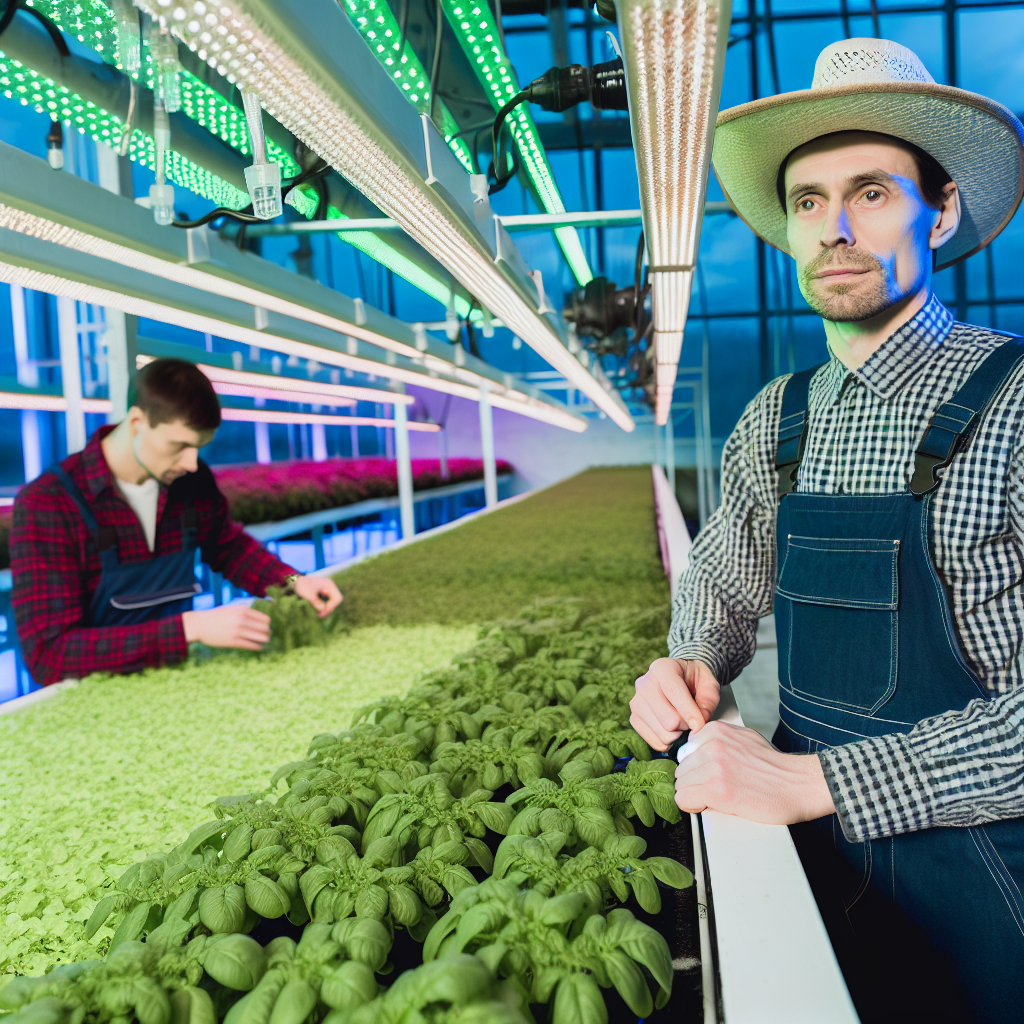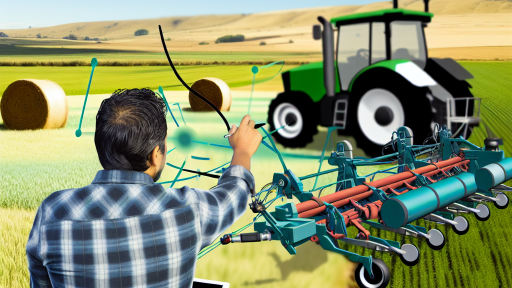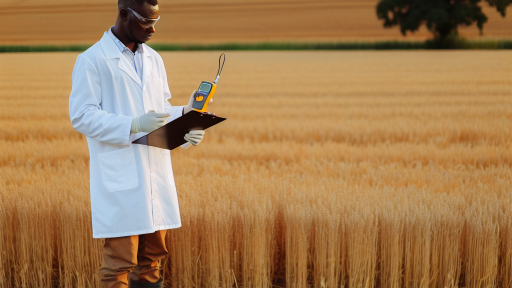Introduction to Controlled Environment Agriculture
Definition of Controlled Environment Agriculture
Controlled Environment Agriculture, or CEA, refers to farming systems that optimize plant growth conditions.
This method includes greenhouse, indoor, and vertical farming techniques.
CEA ensures precise control over environmental variables.
Growers can manage temperature, humidity, light levels, and nutrients more effectively.
This results in higher yields compared to traditional farming practices.
Importance of Controlled Environment Agriculture
CEA plays a crucial role in addressing food security challenges.
As the global population rises, efficient food production becomes vital.
Controlled environments can yield crops year-round, regardless of weather conditions.
Moreover, this method reduces the need for pesticides and herbicides.
Consequently, CEA promotes healthier food options for consumers.
Benefits of Controlled Environment Agriculture
One significant advantage is resource efficiency.
CEA uses significantly less water than traditional agricultural methods.
Additionally, the minimal land requirement allows for urban farming opportunities.
This approach can also reduce transportation costs and carbon emissions.
Farmers can grow crops closer to consumers, enhancing freshness.
Transform Your Agribusiness
Unlock your farm's potential with expert advice tailored to your needs. Get actionable steps that drive real results.
Get StartedChallenges in Implementing CEA
Despite its benefits, CEA comes with challenges.
Initial capital investment for equipment can be high.
Furthermore, technical expertise is required for efficient operation.
Some farmers may struggle with the transition from traditional to modern methods.
Nonetheless, training and support can help overcome these hurdles.
Types of Controlled Environment Agriculture
Hydroponics
Hydroponics involves growing plants in nutrient-rich water without soil.
This method uses a setup of pipes and reservoirs to deliver nutrients effectively.
One significant advantage is the efficient use of water and space.
Additionally, hydroponics can lead to faster plant growth compared to traditional methods.
Core Benefits
- Water conservation due to reduced evaporation.
- Minimal pesticide use ensures cleaner produce.
- Ability to grow crops year-round, regardless of climate.
Aeroponics
Aeroponics is a soilless cultivation technique that uses mist to deliver nutrients.
Plants grow roots suspended in air, allowing for optimal oxygen access.
This technique maximizes nutrient uptake and minimizes water usage.
Moreover, aeroponics encourages strong, healthy plants due to reduced disease exposure.
Key Features
- High efficiency in nutrient absorption due to exposed roots.
- Less space required for crop growth than traditional farming.
- Shorter plant growth cycles lead to increased yields.
Greenhouses
Greenhouses provide a controlled environment for plant growth using transparent materials.
They trap sunlight and maintain heat, creating ideal conditions for various crops.
Moreover, greenhouses can be fitted with automated systems to control moisture and temperature.
This method allows for extended growing seasons and protection from harsh weather.
Advantages of Greenhouses
- Protection from pests and extreme weather conditions.
- Improved quality and yield of produce.
- Ability to grow a wide variety of crops in a single location.
Assessing Your Farm
Evaluating Needs
Your first step is to identify your specific agricultural needs.
Consult with local agricultural experts to gather insights.
Consider the types of crops you want to grow.
Evaluate your goals for sustainability and productivity.
This assessment helps establish a clear direction for your project.
Identifying Resources
Next, examine the resources available on your farm.
Check the availability of water sources for irrigation.
Showcase Your Farming Business
Publish your professional farming services profile on our blog for a one-time fee of $200 and reach a dedicated audience of farmers and agribusiness owners.
Publish Your ProfileAssess the quality of your soil and potential amendments needed.
Look into the existing farming equipment you already own.
This evaluation will guide your investment decisions.
Reviewing Existing Infrastructure
Take stock of your current infrastructure and its suitability.
Inspect your buildings for necessary modifications.
Consider whether your current layout supports controlled environment agriculture.
If not, think about potential redesigns to enhance efficiency.
This process sets the stage for any construction or renovation work.
Gain More Insights: Sustainable Harvesting Techniques Leveraging Advanced Technologies
Designing Your CEA System
Key Components
Controlled Environment Agriculture (CEA) relies on several key components.
Each element plays a crucial role in optimizing plant growth.
Start with climate control systems for temperature and humidity management.
These systems maintain the ideal conditions for crop health.
Next, choose proper lighting solutions to support photosynthesis.
LED grow lights are particularly effective for energy efficiency.
Additionally, consider irrigation systems that minimize water usage.
Drip irrigation can provide precise water delivery to plants.
Lastly, integrate nutrient delivery systems to fulfill plant requirements.
Hydroponic or aeroponic techniques can enhance nutrient absorption.
Layout Design
The layout of your CEA system influences productivity and workflow.
First, assess the available space on your farm.
Design a layout that maximizes light exposure for all plants.
Consider vertical farming options to utilize vertical space effectively.
Next, ensure easy access for maintenance and harvesting tasks.
Implement pathways for movement and equipment access.
Furthermore, establish designated spaces for equipment and storage.
This organization fosters an efficient working environment.
Technology Integration
Integrating technology enhances CEA systems significantly.
Start with monitoring tools to track environmental conditions.
Smart sensors can provide real-time data on temperature and humidity.
Utilize automation systems to control climate and irrigation efficiently.
These systems minimize manual labor and reduce human error.
Moreover, consider using data analytics to improve decision-making.
Analytics can assist in identifying trends and optimizing processes.
Finally, explore mobile applications for remote system management.
Accessing data on-the-go increases flexibility and responsiveness.
Learn More: Sustainability In Agriculture Through Blockchain Supply Chains
Selecting Crops for Controlled Environment Agriculture
Understanding CEA Environment
Controlled Environment Agriculture (CEA) creates optimal growing conditions.
This method enhances growth rate and crop quality.
First, consider the specific environmental conditions of your setup.
Showcase Your Farming Business
Publish your professional farming services profile on our blog for a one-time fee of $200 and reach a dedicated audience of farmers and agribusiness owners.
Publish Your Profile- Light levels
- Temperature ranges
- Humidity levels
These factors significantly influence crop selection.
Choosing Suitable Species
Selecting the right plant species is crucial for success.
Begin with species that thrive in controlled conditions.
Leafy greens, herbs, and certain fruits often perform well.
Examples include basil, spinach, and strawberries.
Research specific growth requirements for each species.
Varieties That Maximize Yield
Diverse varieties of the same species can lead to better yields.
Choose high-yield varieties that are resistant to pests and diseases.
Also, consider the growth period for each variety.
Fast-growing plants optimize space and resources.
Market Demand Considerations
Align crop selection with market trends and demand.
Research local consumer preferences and buying habits.
Growing popular crops can ensure profitability.
Keep a close eye on seasonal trends and emerging varieties.
Trial and Error
Don’t hesitate to experiment with different crops.
Conduct small-scale trials to evaluate performance.
Adjust your crop selection based on these insights.
Document your findings to support future decisions.
Find Out More: Choosing The Right GMO Crops For Your Farm
Environmental Control Strategies
Managing Temperature
Temperature management is crucial in controlled environment agriculture.
It affects plant growth, yield, and overall health.
Implement heating systems for cooler months.
Use cooling systems during hotter periods.
Monitor temperatures regularly using digital sensors.
Adjust settings based on specific crop requirements.
Managing Humidity
Humidity control is essential for preventing diseases.
High humidity can lead to mold and mildew.
Incorporate dehumidifiers in damp conditions.
Use humidistats to maintain optimal levels.
Monitor moisture levels in the growing environment.
Adjust ventilation to balance humidity as needed.
Managing Light
Light influences photosynthesis significantly.
Utilize grow lights to supplement natural sunlight.
Choose spectrums that match plant growth stages.
Use timers for consistent light exposure.
Ensure proper light intensity according to crop type.
Managing Air Quality
Good air quality enhances plant health.
Use fans to promote air circulation.
Implement filtration systems to remove pollutants.
Increase oxygen levels for optimal growth.
Showcase Your Farming Business
Publish your professional farming services profile on our blog for a one-time fee of $200 and reach a dedicated audience of farmers and agribusiness owners.
Publish Your ProfileRegularly monitor carbon dioxide levels in the environment.
Adjust systems to keep air fresh and clean.
Find Out More: Integrating Farm Management Software With Existing Agricultural Tools

Monitoring and Data Management
Importance of Monitoring
Monitoring ensures efficient resource use on your farm.
Consequently, it contributes to maximizing crop yields.
Additionally, it identifies potential problems early.
Data Collection Tools
Various tools help collect vital agricultural data.
For instance, weather stations gather precise climate information.
Soil moisture sensors measure soil hydration levels directly.
Furthermore, drones provide aerial imagery for crop health assessment.
Data Management Software
Effective data management software streamlines your operations.
Tools like FarmLogs help organize and analyze data efficiently.
You can visualize performance trends over time with these tools.
Integration of IoT Devices
Smart devices can enhance monitoring processes.
IoT sensors track conditions in real time.
They provide valuable insights for decision-making.
Using Analytics for Improvement
Data analytics transforms raw data into actionable insights.
These insights help refine agricultural practices.
Overall, they improve productivity and sustainability.
Regular Review and Adjustment
Consistently reviewing data is essential.
This practice enables timely adjustments to strategies.
Ultimately, it creates a responsive management approach.
Cost Analysis and Budgeting
Understanding Initial Investment
Controlled environment agriculture requires a significant initial investment.
First, consider the cost of infrastructure.
This includes greenhouses, lighting, and climate control systems.
Next, evaluate the cost of technology implementation.
Automation and software systems optimize plant production.
In addition, factor in the costs of land preparation.
This may involve soil modifications and irrigation setup.
Operational Costs Evaluation
Ongoing operational costs are crucial for budgeting.
Monitor expenses related to energy consumption regularly.
Lighting and heating can significantly impact your bottom line.
Moreover, consider water and nutrient inputs as recurring expenses.
Labor costs also play a major role in operational budgeting.
Efficient labor management can reduce these costs over time.
Budgeting Strategies
A detailed budget helps manage costs effectively.
Start by establishing a clear financial plan.
Include both fixed and variable costs for transparency.
Next, use forecasting tools for expense prediction.
This ensures you’re prepared for fluctuations in costs.
Showcase Your Farming Business
Publish your professional farming services profile on our blog for a one-time fee of $200 and reach a dedicated audience of farmers and agribusiness owners.
Publish Your ProfileFinally, review and adjust your budget regularly.
Continuous assessment prevents cost overruns and financial strain.
Funding Options
Explore various funding sources for your project.
Government grants may offer financial assistance for innovation.
Additionally, seek venture capital for larger investments.
Local agricultural programs could provide low-interest loans.
Networking with industry peers often reveals funding opportunities.
Implementation Steps
Initial Assessment
Begin with a thorough evaluation of your current farming practices.
Identify areas where controlled environment agriculture can enhance efficiency.
Consider factors such as crop selection, space utilization, and resource management.
Research and Education
Invest time in learning about controlled environment agriculture technologies.
Attend workshops and webinars hosted by agriculture experts.
Connect with local agricultural extension services for tailored guidance.
Setting Goals
Establish clear goals for your transition to controlled environment agriculture.
Focus on desired outcomes such as yield improvement or resource efficiency.
Document these goals to guide your implementation plan.
Phased Implementation Approach
Start with a pilot project to test controlled environment systems.
Choose a small section of your farm for initial testing.
Gather data on crop performance, costs, and operational challenges.
Technology Integration
Choose appropriate technologies that suit your specific needs.
Explore options such as greenhouses, hydroponics, or aquaponics.
Evaluate the costs and benefits of each technology carefully.
Monitoring and Evaluation
Implement a robust monitoring system to track progress.
Use data analytics tools to assess performance and make adjustments.
Regularly review your goals and refine your strategies based on results.
Scaling Up
Once your pilot project is successful, begin scaling up.
Expand controlled environment practices to other areas of your farm.
Continuously train your team to ensure they adapt to new methods.
Community Engagement
Engage with your local farming community throughout this process.
Share your experiences to foster collaboration and innovation.
Seek feedback and insights from fellow farmers to improve your approach.
Case Studies
Green Valley Farms
Green Valley Farms implemented controlled environment agriculture in 2021.
They focused on vertical farming systems to maximize space.
This method allowed them to increase productivity by 40%.
Additionally, they reduced water usage significantly.
Green Valley reports improved crop quality and consistency.
They have since become a model for local farmers.
Sunny Acres Greenhouse
Sunny Acres Greenhouse adopted hydroponics in their operations.
The transition began in early 2020, focusing on tomatoes and lettuce.
This approach eliminated soil-borne diseases in their crops.
Showcase Your Farming Business
Publish your professional farming services profile on our blog for a one-time fee of $200 and reach a dedicated audience of farmers and agribusiness owners.
Publish Your ProfileConsequently, their harvest yields increased dramatically.
They also expanded their market reach with fresh produce.
Sunny Acres has seen a boost in customer satisfaction.
Mountain View Hydroponics
Mountain View Hydroponics upgraded their facility in 2022.
With advanced climate control systems, they optimize growth conditions.
As a result, they produce crops year-round regardless of weather.
The farm has received accolades for sustainable practices.
Local restaurants now source exclusively from them.
They emphasize the importance of community engagement.
Harvest Innovations
Harvest Innovations is a pioneer in aquaponics technology.
Established in 2019, they combine fish farming with vegetable production.
This symbiotic relationship reduces waste and increases efficiency.
Their farm has achieved net-zero waste status.
Moreover, they provide educational workshops for aspiring farmers.
Harvest Innovations continues to inspire innovation in farming.
Additional Resources
NASA Research Launches a New Generation of Indoor Farming …
Using Space-Age Technology for Down-to-Earth Agriculture | Home




